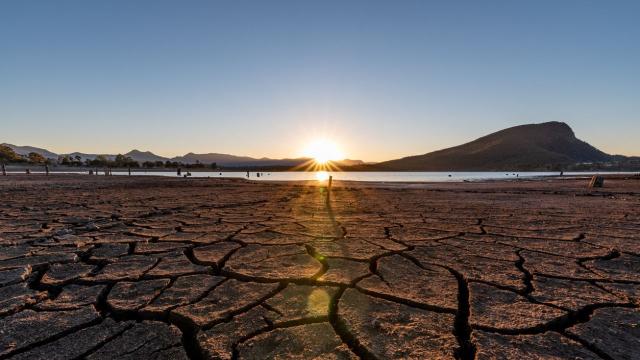For many Australians, the impacts of climate change on wellbeing are distressingly clear.
Floods have recently caused massive damage in many parts of the country, while the 2019/2020 Black Summer bushfires are still seared in our memories.
Climate change will increase the frequency and intensity of such floods and fires, along with droughts, heatwaves and coastal erosion.
Climate change isn’t only a threat to our unique environment, but also a threat to Australia’s national security.
The federal government is already concerned about this issue. When coming into office last year, Prime Minister Anthony Albanese said “The security implications of climate change are clear and cannot be ignored”. He subsequently ordered the Office of National Intelligence to analyse the security implications of climate change. However, the results of this assessment remain classified.
My latest study provides the most comprehensive scientific (and publicly available) assessment of whether climate change affects national security in Australia. The answer to this question is a clear “yes”, even though some qualifications apply.
The biggest risks are damage to critical infrastructure, strained defence force capacity, and the possibility of increased political instability in our region.
Risks to infrastructure
Climate change poses considerable risks to critical infrastructure.
Australia has long road, rail and grid networks, large parts of which are threatened by sea-level rise or located in disaster risk areas.
If you live in Western Australia, you may remember empty supermarket shells in early 2022 when floods washed away a major supply rail line.
Likewise, climate change means more heatwaves. During hot days, demand for energy peaks to keep buildings cool. Simultaneously, high fire risks complicate repair works and bushfires may destroy energy infrastructure. As a result, the likelihood of power outages grows.
Stretching the capacity of the defence force
But climate change doesn’t only threaten civil infrastructure. It also affects the capabilities of the Australian Defence Force (ADF). When it comes to roads or power, the military often depends on the same infrastructure as civilians do, so is affected by similar risks.
The Tanami Road connecting Alice Springs to the Kimberley, for instance, is considered of high strategic importance in case of a larger international conflict. Yet it’s vulnerable to disruptions by floods and extreme heat.
Many military bases are also located close to the ocean and hence threatened by rising sea levels.
The ADF also plays a key role as a provider of disaster relief, both domestically (such as after the Kimberley floods this year) and internationally (such as after Cyclone Winston in Fiji 2016).
The ADF is quite well resourced, but its capacities could be stretched thin if several relevant incidents occur at the same time.
Imagine, for example, several major disasters requiring military responses at a time when ADF infrastructure is affected by climate change, and geopolitical tensions with China are growing.
Political instability
Climate change will also increase the risk of political instability in the Asia-Pacific region.
Research has established that disasters like droughts, floods or storms make violent internal political conflict more likely, particularly in countries with pre-existing risk factors. This is because armed groups have an easier time recruiting impoverished and aggrieved disaster survivors.
Also, states are often weakened after disasters because their military is busy with the disaster response.
In the past, we have observed this link in several countries in Australia’s immediate neighbourhood. In Fiji, for instance, more and more residents are fleeing from coastal floods and storms to larger islands and urban areas. This frequently causes tensions between the newcomers and established residents.
Likewise, Maoist insurgents in India often recruit desperate farmers. Droughts and tropical storms deepen poverty in these rural areas.
In the worst case, Australia’s foreign policy will need to deal with twin challenges: climate-related disasters causing political instability in the region and simultaneously undermining the capabilities of core regional partner countries like Indonesia, which are highly vulnerable to extreme climate events.
Some risks exaggerated
However, my study also finds some climate-related risks are exaggerated.
On the one hand, climate change isn’t a deterministic force of nature, but a result of human action (and inaction). Ambitious CO2-reduction policies and smart adaptation measures could go a long way in reducing the worst impacts of climate change. Decentralised solar energy projects, for instance, help to avoid greenhouse gas emissions and can act as a buffer against disruptions of the power grid.
On the other hand, depictions of climate change as a trigger of international wars and mass migration are misleading.
We have only seen a relatively small number of large-scale violent disputes between states since World War Two, and in none of them was the environment a major cause of contestation. As long as it’s many times cheaper to build a desalination plant than to invade a country, water wars remain unlikely.
What’s more, international migration is enormously costly for the majority of people living in poorer countries. If their livelihoods are further devastated by storms and droughts, they’re even less likely to be able to pay to move long distances.
Despite these qualifications, the message of recent research is unequivocal: climate change is not “just” an environmental concern. It’s an important national security issue for Australia. Efforts to mitigate and adapt to climate change should, consequentially, remain high on the political agenda.![]()
Tobias Ide, Senior Lecturer in Politics and International Relations, Murdoch University
This article is republished from The Conversation under a Creative Commons license. Read the original article.
